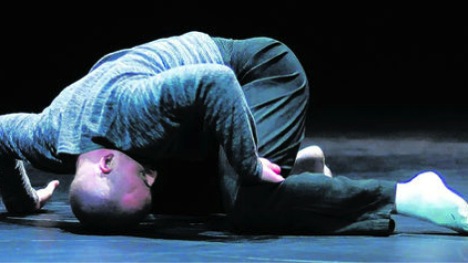[6] Et Encore Plus Heterotopia

...a train is an extraordinary bundle of relations because it is something through which
one goes, it is also something by means of which one can go from one point
to another, and then it is also something that goes by.
—Michel Foucault2
1
You, me, and the train; the train, you, and me. I am not you and I am not the train. I am only walking through the train, to the dining car, perhaps, or back to my seat. The train is passing through Mullingar on its way from Dublin to Sligo. You are a lorry driver stopped at a crossing in Mullingar and watching as the train speeds by. You are in a hurry and somewhat annoyed. I am having tea in the lounge car and, looking out, I see you, but barely, because you are going past so quickly. The dancer is curled up on the floor, his right arm reaches out ahead, curls back under the small of his own back, then thrusts suddenly out! The movements fade in memory as fast as they rise to consciousness, a flow like a movie, there and gone, around the stage like a Chinese dragon dragging its tail in a parade. Do you see me looking out? Did you see me wave? I am sitting and having tea and looking out at you, and waving. All the time I am moving from Dublin toward Sligo. Dublin is sliding away, forgotten; Sligo is waiting. You are gone behind the moving trees, and it takes me just under a mile to finish my tea.
two venerable soldiers
riding on the train, side by side
remembering their
wartime comrades, wondering
where they are now, doing what?
when I was a child
I had a toy. when you blew
on it like a horn
a fat paper snake shot out
puffed up, for just a second
describe the dance’s
penmanship, arms and legs write
in the air, across
the floor. There’s no message, though
just the dancer and the dance
2
If a dancer dances—which is not the same as having theories about dancing or wishing to dance or trying to dance or remembering in his body someone else’s dance—but if the dancer dances, everything is there.... When I dance, it means: this is what I am doing.
—Merce Cunningham3
Here, on the near the side of the road, stands an old farmhouse, the very idea of a farmhouse somewhere in Vermont or Iowa, built to a simple design with a small front porch under an overhang. Over there, you can see in a clearing in the woods what might have begun as a stack of glass-enclosed cubes, that have been twisted into wild irregularity; defying gravity, poised midair like a leaping dolphin, it almost seems to move. The dancer approaches, turns in flight, describing unforeseen marks, faster than the human eye connects them up. He dances along a path that is so quickly taken up, it’s already a memory, an ethereal scaffolding of unseen, unheard-of forms. The house of glass sometimes reflects the sunlight; other times you can see right through it.
vocabularies
from ballet inscribe common
experiences
you can read an arasbeque
fouette or cabriolé
improvisation
and you see the stockinged feet
leap, and crossing each
a stutter of positions
the e.e. cummings of dance
we see things quicker
than we can hear them, think them
much quicker than that
know things hitherto unknown
grasp the nothing, all at once
3
The dance dissociates only on film, where each frame captures a portion and makes an illusion of movements we can number. Otherwise, there is only the fading memory of the dancer having moved, leaped, turned, dropped, and flown. Is there anything else whose components live and die in an instant, forever? All our improvisations, maybe, in speech or music, where words or notes and timing arise and dissipate in an instant forever. Make up the music as you go, as you make up the steps and leaps and the words that are being said, then, make the whole thing up. Why, it’s exactly like an ordinary day, throughout which we improvise the whole way, dancing and talking and humming like crazy. Eating, drinking, walking, talking, making love—oh, you couldn’t rehearse or learn any of it by heart. It all would die in your wooden, mechanical, memorized gestures. The truth is that the most carefully learned and rehearsed routine aims, always and finally, for the illusive, the extempore.
try and draw the dance
where the pictures will be wild
untraceably
no picture of anything
ethereal as architecture
he set out to sketch
the spontaneous movement’s
choreography
rode the moment, unrehearsed
untraceable lines and squiggles
on the lake’s edges
where white winter’s winds blew up
something like a surf
the water piled upon itself
frozen sculptures of pure motion
Bio: Charles D. Tarlton
